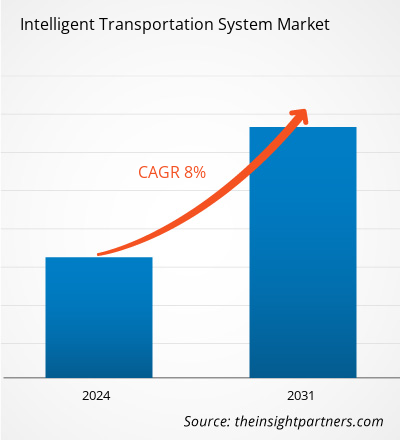智能交通系统市场规模预计将从 2023 年的 359.3898 亿美元增至 2031 年的 663.5513 亿美元。预计该市场在 2023 年至 2031 年期间的复合年增长率为 8.0%。在预测期内,智能交通系统的 V2X 实施可能会成为一种新趋势。
智能交通系统市场分析
道路(城市基础设施的重要组成部分)促进人员流动和物流,是社会和经济增长的基础,连接城市、港口和机场。虽然道路维护和发展促进了经济增长,但交通量的增加会导致交通拥挤和道路事故等问题。近年来,汽车保有量增加的负面后果愈发严重,导致道路交通伤害显著增加,温室气体排放也导致环境恶化。为了改善交通管理和基础设施,智能交通系统 (ITS) 广泛应用基于有线和无线连接的信息通信技术 (ICT)。它能够降低交通风险、缓解交通拥堵、提高交通效率、减少污染,并提升驾驶体验、道路系统安全性和通行能力。通过将尖端通信技术融入交通基础设施和车辆,ITS 能够提高生产力、改善交通运输的机动性和安全性,并增强全球互联互通。因此,预计未来几年对 ITS 的需求将持续增长。智能交通系统 (ITS) 市场的主要驱动力包括:智慧城市计划和基础设施建设的不断推进、跨区域快速城镇化以及政府为加强道路安全而采取的举措。此外,政府机构对改善交通基础设施的重视预计将在预测期内为市场带来丰厚的机遇。然而,系统集成挑战、网络安全威胁和高昂的维护成本是阻碍市场增长的因素。
智能交通系统市场概览
智能交通系统采用最先进的无线、电子和自动化技术来监测、评估和控制交通网络。他们利用信息和通信技术 (ICT) 连接汽车和交通基础设施。因此,无线设备、传感器技术和智能 ICT 服务的优势推动了 ITS 的普及。此外,ITS 在收费、商用车辆运营、交通运营、旅客信息和公共交通领域拥有众多应用,旨在改善交通流量、防止碰撞,并提升乘客的舒适度和安全性。
自定义此报告以满足您的要求
您将免费获得任何报告的定制,包括本报告的部分内容,或国家级分析、Excel 数据包,以及为初创企业和大学提供超值优惠和折扣
智能交通系统市场: 战略洞察

-
获取本报告的主要市场趋势。这个免费样本将包括数据分析,从市场趋势到估计和预测。
智能交通系统市场驱动力与机遇
跨地区快速城镇化推动市场增长
传统交通基础设施被认为在资源配置、污染控制和交通拥堵方面效率低下。通勤交通和汽车拥有量的增加使得对智能解决方案和改进的交通管理技术的需求持续增加。ITS 有助于自动停车、智能交通信号灯和实时公共交通跟踪。交通管理是城市规划和发展的一个重要方面。根据联合国欧洲经济委员会 (UNECE) 的数据,到 2050 年,预计世界 55% 的人口将居住在城市地区。此外,根据世界银行的数据,目前世界 56% 的人口,即 44 亿居民居住在城市。预计这一趋势将持续下去,到 2050 年城市人口将达到新的高度,届时将有近十分之七的人居住在城市。城市创造了全球 80% 以上的 GDP,管理良好的城市化可以提高生产力,促进可持续增长。因此,城市扩张和发展推动了智能交通系统市场的增长。
政府关注交通基础设施
全球范围内,地铁设施、新机场和铁路网络的建设正在增长。2023 年 3 月,加拿大基洛纳市议会批准为基洛纳机场航站楼扩建项目拨款 9000 万美元。截至 2023 年,美国有 6 个新机场在建。2022 年,印度政府宣布计划到 2025 年底建成 220 个机场。2023 年,印度政府批准 39.3 亿美元用于七个变革性铁路项目,以增强连通性。2021 年 11 月,美国国会通过了两党基础设施协议,将投资 1100 亿美元修复和重建全国各地的道路和桥梁。通过关注减缓气候变化、增强适应力、公平性和所有用户的安全,这项投资将用于在未来五年内改造该国状况不佳的道路和高速公路。根据美国总统和加拿大总理于 2023 年 3 月发表的联合声明,加拿大关键矿产基础设施基金将投资约 10.9 亿美元(15 亿加元)用于支持清洁能源和交通基础设施项目。因此,预计全球不断增长的基础设施开发项目将在预测期内为 ITS 市场增长创造丰厚的机会。
智能交通系统市场报告细分分析
有助于得出智能交通系统市场分析的关键细分是类型、系统和应用。
- 根据类型,智能交通系统市场细分为硬件、软件和服务。 2023 年,硬件部分占据了最大的市场份额。硬件类别进一步细分为接口板、传感器、监控摄像头、电信网络、监控和检测系统等。
- 基于系统,智能交通系统市场细分为先进交通管理系统 (ATMS)、先进旅行者信息系统 (ATIS)、支持 ITS 的交通定价系统 (ITPS)、先进公共交通系统 (ATPS)、商用车辆运营 (CVO) 等。2023 年,先进交通管理系统 (ATMS) 部分占据了最大的市场份额。
- 基于应用,市场分为车队管理和资产监控、智能交通控制、智能票务、可变交通信息标志、防撞等。2023 年,智能交通控制部分占据了最大的市场份额。
按地区划分的智能交通系统市场份额分析
智能交通系统市场报告的地理范围主要分为五个地区:北美、亚太地区、欧洲、中东和非洲非洲、南美洲和中美洲。欧洲是全球智能交通系统市场的第二大贡献者,其次是亚太地区。该地区的政府机构正专注于智能出行和 ITS 的实施。例如,2023 年 10 月,为加速欧盟的数字化转型和智能出行,欧盟理事会通过修订 2010 年指令,通过了部署 ITS 的新框架。自动和联网出行、按需出行应用程序和多式联运等技术进步都打算被纳入更新后的指令的考虑范围。此外,该指令还旨在提高互操作性并加快支持导航和多式联运行程规划器的数字数据的可用性。这将使汽车和道路基础设施之间能够通信,以提醒驾驶员注意不可预见的情况,例如前方的交通瓶颈。2022 年 6 月 2 日,欧盟理事会就该提案通过了一般性立场。 2023年6月9日,在与欧洲议会进行跨机构讨论后,就新指令的措辞达成了临时协议。
智能交通系统市场区域洞察
The Insight Partners 的分析师已详尽阐述了预测期内影响智能交通系统市场的区域趋势和因素。本节还讨论了北美、欧洲、亚太地区、中东和非洲以及南美和中美洲的智能交通系统市场细分和地域分布。
智能交通系统市场报告范围
| 报告属性 | 细节 |
|---|---|
| 市场规模 2023 | US$ 35,938.98 Million |
| 市场规模 2031 | US$ 66,355.13 Million |
| 全球复合年增长率 (2023 - 2031) | 8.0% |
| 历史数据 | 2021-2022 |
| 预测期 | 2024-2031 |
| 涵盖的领域 |
By 类型
|
| 覆盖地区和国家 |
北美
|
| 市场领导者和主要公司简介 |
|
智能交通系统市场参与者密度:了解其对商业动态的影响
智能交通系统市场正在快速增长,这得益于终端用户需求的不断增长,而这些需求的驱动因素包括消费者偏好的不断变化、技术进步以及对产品优势的认知度不断提高。随着需求的增长,企业正在扩展其产品线,不断创新以满足消费者需求,并抓住新兴趋势,从而进一步推动市场增长。

- 获取 智能交通系统市场 主要参与者概述
智能交通系统市场新闻及最新发展
智能交通系统市场评估通过收集一手和二手研究后的定性和定量数据进行,这些数据包括重要的企业出版物、协会数据和数据库。以下列出了智能交通系统市场的一些发展:
定位技术专家 TomTom (TOM2) 宣布,正在深化和扩展与微软的合作。TomTom 的地图和交通数据将为微软解决方案中基于位置的服务提供支持,每天惠及数亿个人和组织。两家公司将紧密合作,将创新产品推向市场,包括融合人工智能的产品。此外,TomTom 重申微软 Azure 是其首选云服务提供商。(来源:TomTom,新闻稿,2024 年 7 月)
Kapsch TrafficCom 的自动车牌识别 (ANPR) 软件最近进行了重大更新。根据具体应用,更新后自动车牌识别性能将达到最佳。借助新的 ANPR 软件,人工智能软件能够以符合 GDPR 的方式,使用数十万张照片进行训练,准确可靠地检测车牌。这将有助于识别车辆,而不会造成交通拥堵。 (来源:Kapsch TrafficCom,新闻稿,2023 年 4 月)
智能交通系统市场报告覆盖范围和可交付成果
《智能交通系统市场规模和预测(2021-2031)》报告对市场进行了详细的分析,涵盖以下领域:
- 智能交通系统市场规模和预测,涵盖范围内所有关键细分市场的全球、区域和国家/地区
- 智能交通系统市场趋势以及市场动态,例如驱动因素、限制因素和关键机遇
- 详细的 PEST 和 SWOT 分析
- 智能交通系统市场分析,涵盖关键市场趋势、全球和区域框架、主要参与者、法规和最新市场发展
- 行业格局和竞争分析,涵盖市场集中度、热图分析、知名参与者和智能交通系统市场的最新发展
- 详细的公司简介
- 历史分析(2 年)、基准年、预测(7 年)及复合年增长率
- PEST和SWOT分析
- 市场规模、价值/数量 - 全球、区域、国家
- 行业和竞争格局
- Excel 数据集
近期报告
客户评价
购买理由
- 明智的决策
- 了解市场动态
- 竞争分析
- 客户洞察
- 市场预测
- 风险规避
- 战略规划
- 投资论证
- 识别新兴市场
- 优化营销策略
- 提升运营效率
- 顺应监管趋势






















 获取免费样品 - 智能交通系统市场
获取免费样品 - 智能交通系统市场